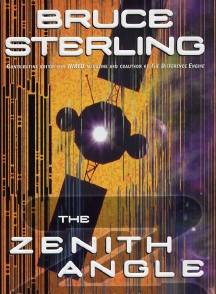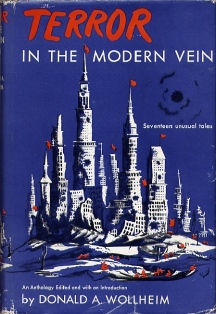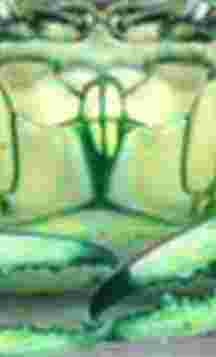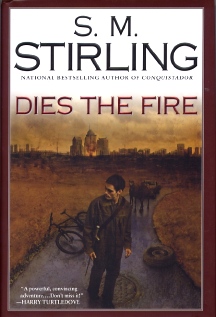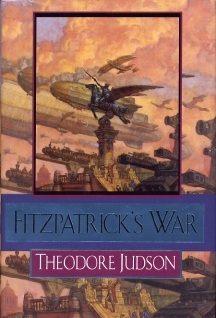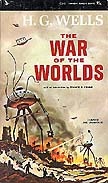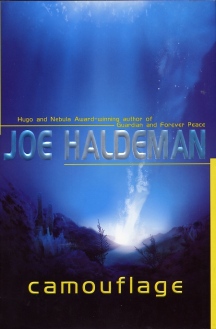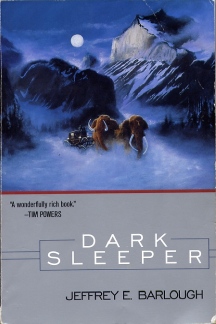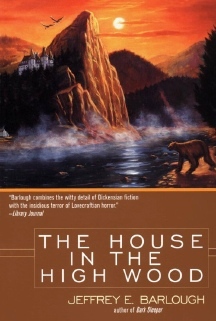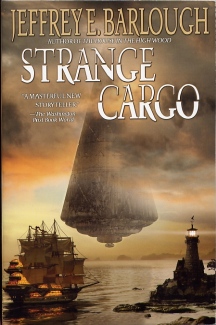|
|
|
This Just in..News from the Agony Column
|
07-22-04: Neal Asher, The Writer Heard 'Round The World; 'Dies the Fire' and the Future Goes Pffft |
|||
Watching
for 'Watchcrab' in Dozois' 'The Year's Best Science Fiction and Fantasy'
I have yet to lay eyes on it myself, but be assured as soon as I do I'll scan the relevant passage for the amusement of my readers. However, if you, the reader are really looking for amusement and haven't read the story yet, please do so. Were I to be pitching it to Hollowood Oh-So-Cool Types, I'd describe it as "Law and Order" meets the critters out of one of Guy N. Smith's infamous 'Crabs' novels. And a good time is had by all who are not scissored in half. Neal also wrote to catch me up on his latest publication news, gathering up the countries and languages he's now available in. "Here you go: USA (Tor US): Gridlinked, Skinner, Cowl. France (Pocket Fleuve): Gridlinked, Skinner. Germany (Bastei-Lubbe): Gridlinked, Skinner, Line of Polity, Cowl, Brass Man, Sable Keech Portugal (Editorial Presenca): Cowl Russia (Eksmo - Moscow): Gridlinked, Skinner, Line of Polity Spain (Distrimagen): Gridlinked Czechoslovakia (Polaris): Skinner Romania (Lucman - Bucharest): Line of Polity, Cowl" I can't imagine that
Tor US is going to let 'The Line of Polity' go; or I should hope not.
Given that he got a very positive New York Times book review that concluded
something along the lines of "Neal Asher gives us the future we
deserve," one would hope that such a deserved future would include
his novels! |
|||
S.
M. Stirling Takes a Crack at Good Ol' Post-Apoplectic Science Fiction
But what happens when you don't get over it, when you can't get over it? What happens when the lights aren't going to come back on? Science fiction writers have been asking that question for a while, but now that I think about it, none has done so quite as directly as S. M. Stirling in his latest novel, 'Dies The Fire' (Penguin-Putnam/Roc, 08-03-04, $23.95). Usually the lights go out for a reason that's hard to ignore. Like, say, somebody got an itchy A-bomb finger, or somebody decided to bring about Apocalypse in an apoplectic fit of rage over the state of Morals In These United States. Whatever the reason, those dropped bombs, or unleashed super-viruses, those gnarly aliens or devestating climate changes usually get more attention than the side effect of the Lights Go Out. But as long as you're not looking up at Buck Henry as he gives his cattle-call swan-song, as long as your flesh is not rotting off your skeleton because You're Not Chosen or you got yourself a lungful o' Superflu, well, who cares about the rest of 'em that are? You care about no more hot food, no more take-out, no more TV and no more Rolling Crones concerts. The lights are off dammit! How can I find the remote? S. M. Stirling has made his name with alternate histories that show verve and imagination. I was particularly enamored of the world he created in 'Shikari in Galveston' and 'The Peshawar Lancers'. He did what great writers do all the time; he bent the rules to create a world that would give him the opportunity to write swashbuckling wild-eyed adventures. His latest novel is straight-ahead science fiction. In the parlance of alternate history fiction, the branchpoint is the day after tomorrow, when an electrical storm over Nantucket (the setting for his 'Islands in the Sea of Time' trilogy) heralds The Change. The Change causes all forms of electronic equipment and even firearms to cease functioning. And thus starts the next Dark Ages. Stirling had quite a bit to say about this novel in the Usenet News Group rec.arts.sf.written. If I recall correctly, he was trying to figure out a way to bring down the firearms with everything else. Well, take that as a given and you do have a rather appealing set of Dark Ages, with all the pesky things we now use to annihilate the world we live on out of action. Of course, you can take the power away from the Evil Doers, but not the Evil itself. So as some people are banding together to survive, others are doing so to conquer. Stirling's a natural talent for playing out a scenario like this. I'll allow that to my mind, it's not quite as enticing as 'The Peshawar Lancers'. Indeed, it sounds like the SCA (Society for Creative Anachronism) might have underwritten the novel. Dump yer guns, get out your swords. No more smart-ass pistol-popping wise-guys to whip it out and shoot ya down. You take out that sword, you better be carving a mighty big bird, or be ready to use it. Funny how a disaster brings out the best in some people and the worst in others. And there's a lesson for you, since it's happening here and now. I can tell you what else is happening here and now; the horse-drawn cars that we see on the cover. I can swear that those damn cars are the ones in front of me whenever I drive anywhere. Maybe I'll ride a bike in that future. It could help me work off some of this anger that I seem to have. |
|
07-21-04: A Memoir of the Future; The War of the Worlds: 143 Book Covers Collected |
|||
'Fitzpatrick's
War' by Theodore Judson
This is after all, science fiction. The great hero of Judson's world is Lord Isaac Prophet Fitzpatrick, who conquered the world in the name of the Yukon in the twenty-fifth century. Though the empire crumbled he's still a hero. But that image is about to get a bit of tarnish as the memoir of one of his lieutenants, Sir Robert Mayfair Bruce, surfaces. Some call Bruce a traitor. But his manuscript suggests that's not the case. 'Fitzpatrick's War' is Bruce's manuscript, with a forward and many annotations by the noted twenty-six century scholar, Doctor Professor Roland Modesty Van Buren. It's a pretty sweet looking novel, 481 pages with an Introduction and lots of footnotes to the text by Van Buren. So what you have here is a meta-fictional experiment of nearly 500 pages set in a low-tech future as the first novel by a new writer. That is no less astonishing than anything that might possibly be in the novel itself. Judson doesn't have any short fiction listed in the Internet Speculative Fiction Database. This is the kind of event that gives one hope for publishing in general and science fiction in specific. Topping off the package is a lovely painting also by someone I've never heard of, who calls him/herself "Gnemo". This just in; A Reader has written me to inform me that Gnemo is really Hugo-nominated artist Tom Kidd. I thought it looked familiar; and thanks to the Kind Reader who let me know! Of course, there is some potential for a novel that doesn't offer whiz-bang spaceships and monsters with four arms, to be well, dull; and of course, the reverse is equally true. But the sheer bravura that goes into the creation of a work like this ensures that some significant passion went into the creation of the book. A brief examination ensures that there's a nicely subversive sense of humor at work here as well. As two characters discuss the wonders of the previous ages, one mentions the theory that:
Well, now that doesn't sound very
science fictional. It sounds downright reasonable. So one begins to wonder
after all: is this science fiction?
Maybe there's something about history we're not being told. Please
note that in spite of the huge page count, the book itself is quite reasonably
priced, which is the only way to ensure that it gets in the bookstores.
Not that the publishers want it to stay there! The rest is up to
you. Break
out your dirigibles. Travel is called for. |
|||
This is literally "just in" from the Ffortean list, but it's too good not to share with my readers. Mark Pilkington, who runs the Strange Attractor website, sent this link to a page where the webmaster has collected 143, count 'em 143 versions of the cover of H. G. Wells' 'The War of the Worlds', from 1898 to 2004. It's a pretty amazing evolution. Harold Poskanzer calls himself "Dr. Zeus" and his collection of book covers is definitely going to be a journey down memory lane for many of us. Moreover, it's a beautiful cultural evolution as well. Follow this link for 143 versions of APOCALYPSE, Victorian Style. |
| 07-20-04: Forever Haldeman | |||
Coming
out from under 'Camouflage'
Haldeman's latest is 'Camouflage'(Penguin-Putnam/Ace, $23.95, August 3, 2004), which conflates a number of ideas that we've seen before into another compact, 296-page narrative. A search for a downed sub that turns up an undersea alien artifact ('The Abyss')? Check. An alien that can morph into anything it wants to be ('Terminator 2') that hunts humans ('Predator')? Check. I'm seeing a pattern of Cameron and Schwarzenegger movies here. Still, there's no real comparison between books and movies. The question is -- and it's pertinent -- what can Haldeman do with his prose? Judging from 'Guardian' that's a lot. He created some really compelling characters and narratives in that novel. However, one is given reasons to both worry and wait with anticipation in the 'Prologue' to this novel. "The monster came from a swarm of stars that humans call Messier 22, a globular cluster ten thousand light years distant." The worrying part comes with the prose, which is strictly functional in the opening passages; the anticipation part comes because Haldeman is writing an up-front monster novel, and well, I have a love of monster novels that sometimes overcomes my better judgment. I have to admit that for a purely cheesy monster movie run, it does bode well that Haldeman is apparently writing for Cameron/Schwarzenegger. The book I read that was clearly written for Stallone was not particularly felicitous. You don't have to journey very far into this novel to find yourself a nice slab of entrails and internal organs worn on the outside. At least our monster is acting like a monster, and not a namby-pamby tourist in a rubber suit. Presumably what Haldeman can bring to the table -- besides, hopefully, his obvious prose skills -- is thirty-something years of experience writing actual science fiction. This is as opposed to the skills that are usually brought to so-called science fiction movies -- a few sittings in front of the titles above, plus '2001: A Space Odyssey' if the screed-writer is feeling particularly literary. In any story, even with the familiar outlines of this one, there's a lot of room for clever writing and interesting conceptualization. Of course, one must hope that Haldeman has not chosen to camouflage his obvious skills. And observe that, even if he has, he's at least chosen to do so concisely. |
|
07-19-04: Western Lights and 'Strange Cargo' |
|||||||||
Welcome Back to Jeffrey E. Barlough
One must give credit to the people at Ace, who were able to recognize Barlough's unique talent and willing to publish it. 'Dark Sleeper' was published by Ace in 2000 as a trade paperback sporting a pertinent and prominent blurb from Tim Powers. There was really nothing like it out there, and there still isn't anyone who writes in the particular and peculiar fashion of Barlough. From the very first page, it's clear that the reader is in for something very different. Barlough has a prodigious imagination, and the world he's created is unique, compelling and very weird. But what you'll first notice is that the author has a prose style that hearkens back to the self-conscious style of Dickens and Lovecraft while managing the rather remarkable feat of remaining funny, light and utterly entertaining to read. For readers who enjoy the act of reading, Barlough is a wonderful treat. Here's a writer who enjoys the act of writing so much that he manages to share that joy with you in every word choice and sentence construction. Barlough comes off as more of a raconteur than a mere writer. He enjoys the telling of the tale so much, the reader can hardly help but return the favor. Once the reader has been sucker-punched by the unique prose, the strangeness of what that prose is used to create slowly reveals itself. Barlough's world takes a slice of the California coast, butts it up against a continent with a prehistoric inventory of wildlife and a sort of magical science that allows the supernatural and science-fictional to blend under the cover of the pea-soup fogs that line the coast. Barlough deploys these elements at what seems to be a leisurely pace but is soon revealed to be laden with sinister and intricate details that ratchet up the tension and the terror with an agreeable subtlety. He finishes matters in an extremely satisfying manner, with a payoff that worthy of the buildup.
But there's more at work in this novel than a simple tour of weird times in weird climes. Barlough finishes off the novel in a manner that will surprise and shock without schlock even the most jaded reader. Like Lovecraft, Barlough knows that less is certainly better when trying to send a shiver down the reader's spine. So when I started this site in 2002, I was looking for the new Barlough book -- and there was none to be found. I continued looking and waiting, waiting and looking, reminded of how much I liked this author every time I lent one of his books to another friend. No matter how diverse their tastes, to a one my reading buddies enjoyed the novels every bit as much as I did. And while the Dickens, Lovecraft and Powers references are all pertinent, they only hint at what the reader finds in the novels. Barlough is doing something totally unique and he does it with a unique style. His writing is startling in its originality on all counts; in the prose, in the plot and in the characters. There's no reward too great for this.
While I enjoyed the previous books immensely, I must say that Ace has certainly found a much better cover artist in Gregory Bridges. The cover is gorgeous, eye-catching and spot-on topic, capturing both the mood and the substance of the books. From what I can discern, I believe what we see on the cover is what happens in the first chapter of the novel. Further scanning of the novel did reveal the usual mix of charming Dickensian whimsy and terrorizing monsters. If you've not read Barlough, you can still find all his books, though the first is officially out of print. Now, though the series is all set in the same peculiar world, they are not sequential, and each can be read as a standalone work. Still, always best to read things in the chronological order of publication, to get a feel of the writer growing. But in a pinch, you can plop down, read this novel and then hit the search engines to pick up his others. But trust me, you’re going to want to read them when you finish this one. Barlough is highly skilled and totally original. And published! How that for shock value? |
